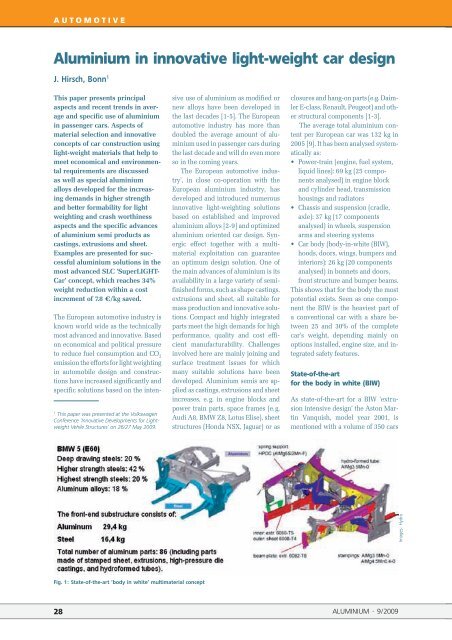special - Alu-web.de
special - Alu-web.de
special - Alu-web.de
Create successful ePaper yourself
Turn your PDF publications into a flip-book with our unique Google optimized e-Paper software.
A U t o M o t I v E<br />
<strong>Alu</strong>minium in innovative light-weight car <strong>de</strong>sign<br />
J. Hirsch, Bonn 1<br />
This paper presents principal<br />
aspects and recent trends in average<br />
and specific use of aluminium<br />
in passenger cars. Aspects of<br />
material selection and innovative<br />
concepts of car construction using<br />
light-weight materials that help to<br />
meet economical and environmental<br />
requirements are discussed<br />
as well as <strong>special</strong> aluminium<br />
alloys <strong>de</strong>veloped for the increasing<br />
<strong>de</strong>mands in higher strength<br />
and better formability for light<br />
weighting and crash worthiness<br />
aspects and the specific advances<br />
of aluminium semi products as<br />
castings, extrusions and sheet.<br />
Examples are presented for successful<br />
aluminium solutions in the<br />
most advanced SLC ’SuperLIGHT-<br />
Car’ concept, which reaches 34%<br />
weight reduction within a cost<br />
increment of 7.8 €/kg saved.<br />
The European automotive industry is<br />
known world wi<strong>de</strong> as the technically<br />
most advanced and innovative. Based<br />
on economical and political pressure<br />
to reduce fuel consumption and CO 2<br />
emission the efforts for light weighting<br />
in automobile <strong>de</strong>sign and constructions<br />
have increased significantly and<br />
specific solutions based on the inten-<br />
1 This paper was presented at the Volkswagen<br />
Conference ’Innovative Developments for Lightweight<br />
Vehile Structures’ on 26/27 May 2009.<br />
Fig. 1: State-of-the-art ’body in white’ multimaterial concept<br />
sive use of aluminium as modified or<br />
new alloys have been <strong>de</strong>veloped in<br />
the last <strong>de</strong>ca<strong>de</strong>s [1-5]. The European<br />
automotive industry has more than<br />
doubled the average amount of aluminium<br />
used in passenger cars during<br />
the last <strong>de</strong>ca<strong>de</strong> and will do even more<br />
so in the coming years.<br />
The European automotive industry’,<br />
in close co-operation with the<br />
European aluminium industry, has<br />
<strong>de</strong>veloped and introduced numerous<br />
innovative light-weighting solutions<br />
based on established and improved<br />
aluminium alloys [2-9] and optimized<br />
aluminium oriented car <strong>de</strong>sign. Synergic<br />
effect together with a multimaterial<br />
exploitation can guarantee<br />
an optimum <strong>de</strong>sign solution. One of<br />
the main advances of aluminium is its<br />
availability in a large variety of semifinished<br />
forms, such as shape castings,<br />
extrusions and sheet, all suitable for<br />
mass production and innovative solutions.<br />
Compact and highly integrated<br />
parts meet the high <strong>de</strong>mands for high<br />
performance, quality and cost efficient<br />
manufacturability. Challenges<br />
involved here are mainly joining and<br />
surface treatment issues for which<br />
many suitable solutions have been<br />
<strong>de</strong>veloped. <strong>Alu</strong>minium semis are applied<br />
as castings, extrusions and sheet<br />
increases, e. g. in engine blocks and<br />
power train parts, space frames (e. g.<br />
Audi A8, BMW Z8, Lotus Elise), sheet<br />
structures (Honda NSX, Jaguar) or as<br />
closures and hang-on parts (e.g. Daimler<br />
E-class, Renault, Peugeot) and other<br />
structural components [1-3].<br />
The average total aluminium content<br />
per European car was 132 kg in<br />
2005 [9]. It has been analysed systematically<br />
as:<br />
• Power-train (engine, fuel system,<br />
liquid lines): 69 kg (25 compo-<br />
nents analysed) in engine block<br />
and cylin<strong>de</strong>r head, transmission<br />
housings and radiators<br />
• Chassis and suspension (cradle,<br />
axle): 37 kg (17 components<br />
analysed) in wheels, suspension<br />
arms and steering systems<br />
• Car body (body-in-white (BIW),<br />
hoods, doors, wings, bumpers and<br />
interiors): 26 kg (20 components<br />
analysed) in bonnets and doors,<br />
front structure and bumper beams.<br />
This shows that for the body the most<br />
potential exists. Seen as one component<br />
the BIW is the heaviest part of<br />
a conventional car with a share between<br />
25 and 30% of the complete<br />
car’s weight, <strong>de</strong>pending mainly on<br />
options installed, engine size, and integrated<br />
safety features.<br />
State-of-the-art<br />
for the body in white (bIW)<br />
As state-of-the-art for a BIW ’extrusion<br />
intensive <strong>de</strong>sign’ the Aston Martin<br />
Vanquish, mo<strong>de</strong>l year 2001, is<br />
mentioned with a volume of 350 cars<br />
28 ALUMINIUM · 9/2009<br />
Images: Hydro
















